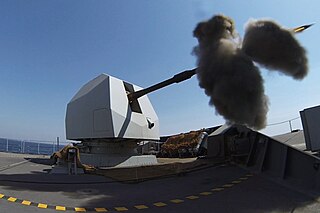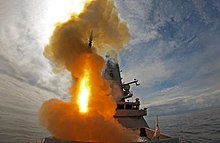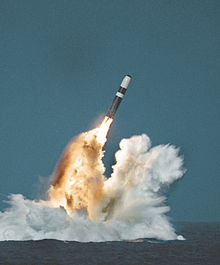
The TomahawkLand Attack Missile (TLAM) is a long-range, all-weather, jet-powered, subsonic cruise missile that is primarily used by the United States Navy and Royal Navy in ship and submarine-based land-attack operations.

The Trafalgar class is a class of nuclear-powered fleet submarines (SSNs) in service with the Royal Navy, and the successor to the Swiftsure class. Like the majority of Royal Navy nuclear submarines, all seven boats were constructed at Barrow-in-Furness shipyard, Cumbria. With only one boat remaining active and in commission and six retired from the seven originally in service, the class makes up part of the Royal Navy's nuclear-powered ‘hunter-killer’ submarine force. The Trafalgar class has nearly been replaced by the larger and more capable Astute class, of which five are commissioned.

The Type 23 frigate or Duke class is a class of frigates built for the United Kingdom's Royal Navy. The ships are named after British Dukes, thus leading to the class being commonly known as the Duke class. The first Type 23, HMS Norfolk, was commissioned in 1989, and the sixteenth, HMS St Albans was commissioned in June 2002. They form the core of the Royal Navy's destroyer and frigate fleet and serve alongside the Type 45 destroyers. They were designed for anti-submarine warfare, but have been used for a range of uses. Ten Type 23 frigates remain in service with the Royal Navy, with three vessels having been sold to the Chilean Navy, one being retired in 2021, and two being retired in 2023.

HMS Triumph is a Trafalgar-class nuclear submarine of the Royal Navy and was the seventh and final boat of her class. She is the nineteenth nuclear-powered hunter-killer submarine built for the Royal Navy. Triumph is the tenth vessel, and the second submarine, to bear the name. The first HMS Triumph was a 68-gun galleon built in 1561. As of 2022, she is the last boat of her class remaining in service.

The Type 45 destroyer, also known as the D or Daring class, is a class of six guided-missile destroyers built for the United Kingdom's Royal Navy in the early 21st century. The class is primarily designed for anti-aircraft and anti-missile warfare and is built around the PAAMS air-defence system using the SAMPSON Active electronically scanned array (AESA) and the S1850M long-range radars. The first three destroyers were assembled by BAE Systems Surface Fleet Solutions from partially prefabricated "blocks" built at different shipyards; the remaining three were built by BAE Systems Maritime – Naval Ships. The first ship in the Daring class, HMS Daring, was launched on 1 February 2006 and commissioned on 23 July 2009.

HMS Iron Duke is a Type 23 frigate of the Royal Navy, and the third ship to bear the name.

HMS Ambush is an Astute-class nuclear-powered attack submarine of the Royal Navy, the second boat of her class.
HMS Artful is the third Astute-class nuclear-powered fleet submarine of the British Royal Navy. She is the second submarine of the Royal Navy to bear this name. Artful was ordered from GEC's Marconi Marine on 17 March 1997, and was constructed at Barrow in Furness. She was named on 20 September 2013, was rolled out of the shipyard construction hall on 16 May 2014, and was due to start sea trials in early 2015. Artful made her first successful basin dive in October 2014, and sailed on 13 August 2015 for sea trials. Artful was handed over the Royal Navy on 14 December 2015, and commissioned on 18 March 2016.

HMS Dido was a Royal Navy (RN) Leander-class frigate. Entering service in 1961, Dido was involved in the Indonesia–Malaysia confrontation, served with NATO's Standing Naval Force Atlantic on several occasions, and was one of the frigates used for the filming of the drama series Warship.
HMS Phoebe (F42) was a Leander-class frigate of the Royal Navy (RN). She was, like the rest of her class, named after a figure of mythology. Built by Alexander Stephen and Sons on the River Clyde, she was launched on 19 December 1964 and commissioned on 15 May 1966.

The Type 82 or Bristol-class destroyer was a 1960s guided missile destroyer design intended to replace County-class destroyers in the Royal Navy. Originally eight warships were planned to provide area air-defence for the four planned CVA-01 aircraft carriers. They would also have been able to operate independently as modern cruisers "East of Suez".

Future planning of the Royal Navy's capabilities is set through periodic Defence Reviews carried out by the British Government. The Royal Navy's role in the 2020s, and beyond, is outlined in the 2021 defence white paper, which was published on 22 March 2021. The white paper is one component of the Integrated Review of Security, Defence, Development and Foreign Policy, titled as Global Britain in a Competitive Age which was published on 16 March 2021.

The Type 26 frigate, also known as City-class frigate, is a class of frigates being built for the United Kingdom's Royal Navy, with variants also being built for the Australian and Canadian navies. The programme, known as the Global Combat Ship, was launched by the British Ministry of Defence to partially replace the navy's thirteen Type 23 frigates, and for export. Its primary role is to conduct advanced anti-submarine warfare missions while supporting air defence and general purpose operations. The type is the first naval platform shared between Australia, Canada and the United Kingdom since the pre-Second World War Tribal-class destroyer.

The Rothesay class, or Type 12M frigates were a class of frigates serving with the Royal Navy, South African Navy and the Royal New Zealand Navy.

HMS Diamond is the third ship of the Type 45 or Daring-class air-defence guided missile destroyers built for the Royal Navy. She was launched in 2007, and completed her contractor's sea trials and arrived at her base port in 2010. Diamond formally entered service in 2011.

The 4.5 inch Mark 8 is a British naval gun system which currently equips the Royal Navy's destroyers and frigates, and some British destroyers and frigates sold to other countries.

The AgustaWestland AW159 Wildcat is a military helicopter, developed by the British-Italian helicopter manufacturer AgustaWestland, and later marketed by the Italian aerospace company Leonardo. It is an improved version of the Westland Super Lynx designed to serve in the battlefield utility, search and rescue, aerial reconnaissance, anti-submarine warfare (ASW), anti-surface warfare (ASuW), utility, command and control, and troop transport duties.

The 30mm DS30M Mark 2 is a ship-protection system made by MSI-Defence Systems consisting of a 30mm Mark 44 Bushmaster II cannon on an automated mount. It was designed to defend Royal Navy frigates from fast inshore attack craft armed with short-range missiles, rocket-propelled grenades, machine guns, or explosives.

Martlet or the Lightweight Multirole Missile(LMM) is a lightweight air-to-surface, air-to-air, surface-to-air, and surface-to-surface missile developed by Thales Air Defence for the United Kingdom. It is named after a mythical bird from English heraldry that never roosts, the Martlet.
The FC/ASW, FMAN/FMC, FOSW or SPEAR 5 is a next generation missile programme launched by France and the United Kingdom in 2017 to succeed their jointly-developed Storm Shadow/SCALP as well as their respective Exocet and Harpoon anti-ship missiles. Equally funded by both countries, the project is led by European missile manufacturer MBDA and is a product of the close defence relationship set out between both nations by the Lancaster House treaties. In June 2023, it was announced Italy would join the programme and began allocating funding in November.





















